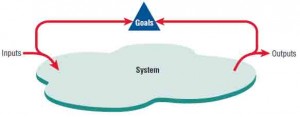Organizations and their members are usefully conceptualized as systems designed to accomplish predetermined goals and objectives through people and other resources that they employ. Organizations are composed of smaller, interrelated systems (departments, units, divisions, etc.) serving specialized functions. Typical functions include accounting, marketing, production, data processing, and management. Specialized functions (smaller systems) are eventually reintegrated through various ways to form an effective organizational whole.
The significance of conceptualizing organizations as complex systems is that systems principles allow insight into how organizations work. To ascertain information requirements properly and to design appropriate information systems, it is of primary importance to understand the organization as a whole. All systems are composed of subsystems (which include information systems); therefore, when studying an organization, we also examine how smaller systems are involved and how they function.
Interrelatedness and Interdependence of Systems
All systems and subsystems are interrelated and interdependent. This fact has important implications both for organizations and for those systems analysts who seek to help them better achieve their goals. When any element of a system is changed or eliminated, the rest of the system’s elements and subsystems are also significantly affected.
For example, suppose that the managers of an organization decide not to hire administrative assistants any longer and to replace their functions with networked PCs. This decision has the potential to significantly affect not only the administrative assistants and the managers but also all the organizational members who built up communications networks with the now departed assistants. All systems process inputs from their environments. By definition, processes change or transform inputs into outputs. Whenever you examine a system, check to see what is being changed or processed. If nothing is changed, you may not be identifying a process. Typical processes in systems include verifying, updating, and printing.
Another aspect of organizations as systems is that all systems are contained by boundaries separating them from their environments. Organizational boundaries exist on a continuum ranging from extremely permeable to almost impermeable. To continue to adapt and survive, organizations must be able first to import people, raw materials, and information through their boundaries (inputs), and then to exchange their finished products, services, or information with the outside world (outputs).
Feedback is one form of system control. As systems, all organizations use planning and control to manage their resources effectively. Figure below shows how system outputs are used as feedback that compares performance with goals. This comparison in turn helps managers formulate more specific goals as inputs. An example is a U.S. manufacturing company that produces red-white-and-blue weight-training sets as well as gun-metal gray sets. The company finds that one year after the Olympics, very few red-white-and-blue sets are purchased. Production managers use that information as feedback to make decisions about what quantities of each color to produce. Feedback in this instance is useful for planning and control.

System outputs serve as feedback that compares performance with goals.
The ideal system, however, is one that self-corrects or self-regulates in such a way that decisions on typical occurrences are not required. An example is a supply chain system for production planning that takes into account current and projected demand and formulates a proposed solution as output. An Italian knitwear manufacturer that markets its clothing in the United States has just such a system. This company produces most of its sweaters in white, uses its computerized inventory information system to find out what colors are selling best, and then dyes sweaters in hot-selling colors immediately before shipping them.
Feedback is received from within the organization and from the outside environments around it. Anything external to an organization’s boundaries is considered to be an environment. Numerous environments, with varying degrees of stability, constitute the milieu in which organizations exist.
Among these environments are:
- The environment of the community in which the organization is physically located, which is shaped by the size of its population and its demographic profile, including factors such as education and average income;
- The economic environment, influenced by market factors, including competition;
- The political environment, controlled through state and local governments; and
- The legal environment, issuing federal, state, regional, and local laws and guidelines. Although changes in environmental status can be planned for, they often cannot be directly controlled by the organization.
Related and similar to the concept of external boundary permeability is the concept of internal openness or closedness of organizations. Openness and closedness also exist on a continuum, because there is no such thing as an absolutely open or completely closed organization. Openness refers to the free flow of information within the organization. Subsystems such as creative or art departments often are characterized as open, with a free flow of ideas among participants and very few restrictions on who gets what information at what time when a creative project is in its infancy.
At the opposite end of the continuum might be a defense department unit assigned to work on top-secret defense planning affecting national security. Each person needs to receive clearance, timely information is a necessity, and access to information is only on a “need to know” basis. This sort of unit is constrained by numerous rules.
Using a systems overlay to understand organizations allows us to acknowledge the idea of systems composed of subsystems; their interrelatedness and their interdependence; the existence of boundaries that allow or prevent interaction between various departments and elements of other subsystems and environments; and the existence of internal environments characterized by degrees of openness and closedness, which might differ across departments, units, or even systems projects.
Contents
- Organizations as Systems
- Virtual Organizations and Virtual Teams
- Taking a Systems Perspective
- Enterprise Systems: Viewing the Organization as a System
- Systems and the Context-Level Data Flow Diagram
- Systems and the Entity-Relationship Model
- Use Case Modeling / Use Case Symbols
- Use Case Relationships
- Developing Use Case Diagrams & Use Case Scenarios
- Use Case Levels (Use case Modeling)
- Levels of Management
- Organizational Culture
